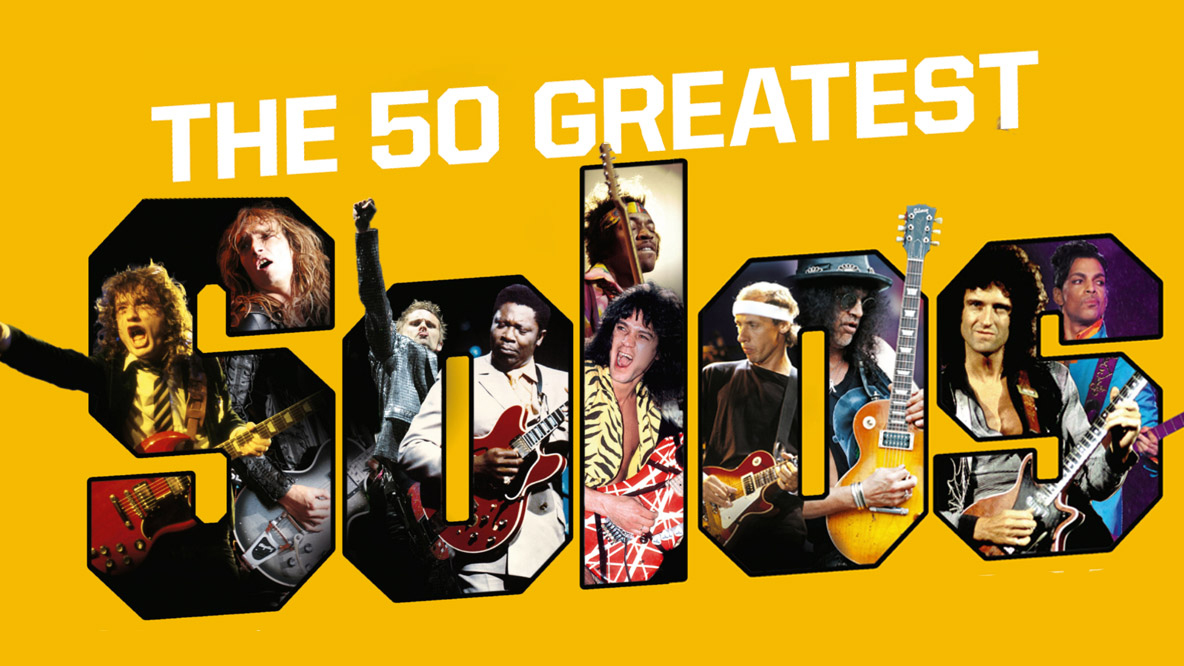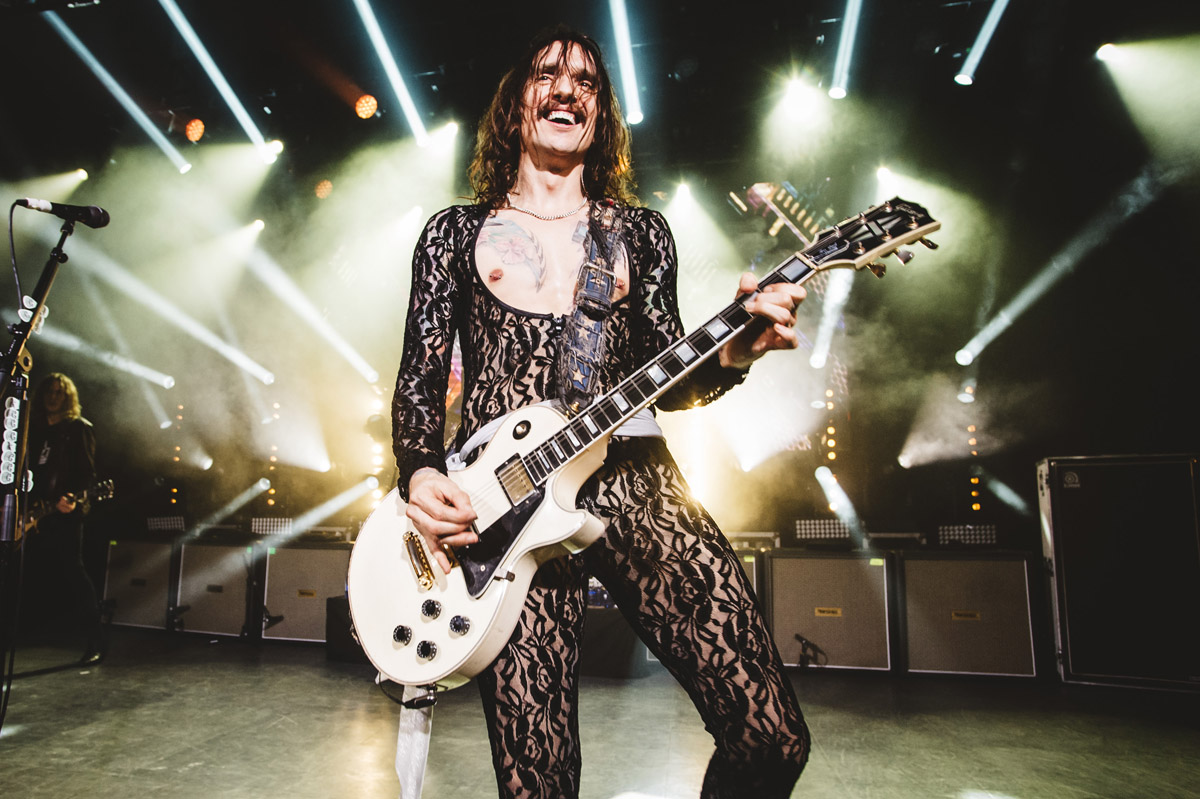The 50 greatest guitar solos of all time
The best lead playing ever committed to record, as voted by you

The thorny subject of the greatest guitar solo of all time has long been a fiercely contested debate. Probably because every solo is different. How do you compare, say, Comfortably Numb with Crazy Train, or Stairway To Heaven with Sultans Of Swing?
It’s impossible. Still, public opinion ebbs and flows, and we wanted to find out which solos currently rank among our readers as the greatest of them all.
Some weeks back, we ran a poll on Guitar World to find out, and here, we’ll take you through the results. We’ll dive into the stories behind the songs and find out just what made those lead guitar breaks so great.
We’ve spoken with Genesis legend Steve Hackett, glam rocker Justin Hawkins, Metallica’s Kirk Hammett and more.
Due to the sheer scale of this feature, we've spread it out over multiple pages to aid load times. Use the dropdown above, and the numbers below to navigate the article.
So, without further ado, here are the greatest guitar solos of all time, as voted for by you…
The 50 greatest solos of all time: 50-41
50. Parabola – Tool (Guitarist: Adam Jones, 2001)
As fans of the world-conquering four-piece have noted, there’s really two different Tools on record. The former concerns the band’s early days, specifically the Opiate EP and their debut album Undertow, with songs built around grinding riffs courtesy of bassist Paul D’Amour.
Get The Pick Newsletter
All the latest guitar news, interviews, lessons, reviews, deals and more, direct to your inbox!
With the addition of Justin Chancellor in 1995, the band’s second and current phase moved towards complex prog, and by 2001’s Lateralus they were a group changed irreversibly.
The inclusion of Parabola’s (albeit short) solo takes guitarist Adam Jones away from the solo-shy, riff-centric styles of his contemporaries, brushing off the hallmarks of typical 90s and 00s alternative music. Though not Jones’ first solo on a Tool song, his use of melody in Parabola’s lead break indicates his growth as a composer, and the addition of polyrhythmic harmonics are a demonstration of his creativity.
49. Jessica – The Allman Brothers Band (Guitarist: Dickey Betts, 1973)
Word is Dickey Betts wrote this as a tribute to Django Reinhardt, which is why it’s possible to play with just two fingers, Reinhardt having lost the use of his other fingers. Sonically though, this is pure southern rock. An Allman Brothers secret is adding the perfect 4th to the major pentatonic (in A major this is A-B-C#-D-E-F#), and that sound is here in abundance.
Despite the regular appearance of the note G natural in the rhythm guitar part, giving a Mixolydian sound, that note never appears in the main theme and is used sparingly in the solo.
The solo itself is a masterclass in using repeated motifs to build an interesting solo. Where other guitarists fear repeating themselves, Betts creates hooks and themes by returning to two or three core ideas.
48. Nutshell – Alice In Chains (Guitarist: Jerry Cantrell, 1994)
This song doesn’t have a chorus as such. Instead, Jerry Cantrell’s memorable pentatonic licks serve as a hook alongside the backing vocals. Nutshell has been voted one of the saddest songs of all time, and Cantrell’s guitar takes over as Layne Staley’s lyrics reach a peak of despair, as though the guitar speaks when mere words are insufficient.
The use of delay is particularly effective at 3:34, when Cantrell slides spectacularly upwards off a note, which is then repeated a beat later.
His Van Halen influence is obvious in the ensuing legato licks, which are surprisingly shreddy for a grunge-era hit. And then, brilliantly, Cantrell simply stops playing as the groove continues, allowing the listener to sit in the well of emotion the band has just conjured.
47. Gravity – John Mayer (2005)
Mayer is without doubt the 21st century’s most popular blues guitarist, and this remarkably compact offering shows why. A four-minute pop song with succinct and melodic guitar breaks, Gravity has exactly as much guitar as it needs.
Mayer’s exceptional bending and vibrato bring to mind Peter Green and BB King, and few players have made a Strat sound so clean and so warm at the same time. Mayer knows how to develop ideas rather than merely repeat them.
At 2:17 he plays a lick and then repeats it twice as fast; from 2:25 he plays a clever double bend lick and then transposes it further down the scale. But it’s his mastery of sliding that really stands out, with a spectacular glissando to finish as the vocal comes back in.
46. Paranoid Android – Radiohead (Guitarist: Jonny Greenwood, 1997)
One of the most successful examples of the anti-guitar-god movement, Radiohead have built a career rallying against the cliches of rock. Ever reluctant to conform, the brilliantly imaginative Johnny Greenwood has proven that he relishes the opportunity to turn a traditional solo on its head.
Paranoid Android’s first, shorter solo comes after three minutes of ominous riffing that builds slowly to a noisy guitar freak-out. Greenwood begins with intense tremolo picking – a flurry of notes that distress the listener.
For the outro solo, Jonny then employs both regular and reversed guitar parts and string bends a-plenty through the envelope filter of his Mutronics Mutator rack unit. It’s no exaggeration to suggest that Greenwood’s solo genuinely sounds more like droid from Star Wars having a meltdown than a traditional guitar – which is, of course, entirely the idea.
45. Maggot Brain – Funkadelic (Guitarist: Eddie Hazel, 1971)
In the year following Hendrix’s death, the rock press searched for a worthy heir – and most concluded it was Funkadelic’s Eddie Hazel who most deserved the title. Maggot Brain, his definitive guitar statement, is a ten-minute improvisation laid down in one take. Like Hendrix, Hazel finds joy in fuzz, wah, whammy and feedback, and gives himself the space to explore every sound his Strat can make. At five minutes, it’s nearly clean.
By eight minutes, Hazel has produced the most extreme Velcro fuzz tone. Hazel initially recorded with a full band, but Funkadelic leader George Clinton faded most of them out and created the spacey backing on the final track, adding multiple layers of Echoplex to Hazel’s guitar explorations. For great musicians, even guitar solos can be collaborative events.
44. I Believe In A Thing Called Love – The Darkness (Guitarist: Justin Hawkins)

Justin Hawkins: “In this song I had the first solo, which was fairly easy to play, with a few of those licks I try to stick in pretty much everything. It’s more of a first chorus tag kind of thing. Then I was tasked with having the run home near the end. I always start off with a big saucy bend, that’s always been my thing I guess.
“There’s a harmony guitar or two in there as well – in fact there’s all sorts of things going on under the hood, including five seconds of dramatic monologue for the discerning listener with a good stereo. From that opening bend, it’s all blues stuff around the 12th fret really.
“I like to call it the humble blues scale! I climb down the scale and then end that run with another saucy bend... What can I say, people love saucy bends! “For the opening section I was clearly trying to be Brian May, but then comes this almost funky bit on the D and G strings where I’m going for more of a Slash vibe. And there’s more of that humble blues scale – honestly, you really can’t knock it!
I have to say the guitars were recorded properly on this album. That’s the one thing that we nailed
Justin Hawkins
“It’s not quite pentatonic because you have that extra note in there... I actually find the more extra notes you include, the more it makes everything sound posh. “The next bit is where I was trying to be Billy Duffy from The Cult. On the Electric album, there’s that song called Bad Fun where he uses hammer-ons and pull-offs against an open string. I decided to do that on the top string to get myself up to where I wanted to be.“
“I love soloing in E and especially on Les Pauls, because there’s always an ‘out’ by bending on the highest fret you can have. It looks spectacular live because you can reach over the top of the neck and pull it with first finger on the fretting hand. It’s perfectly feasible and justified, in some instances. I suppose this solo does deserve to be in this list, because I ended up copying everyone that matters to me... Justin’s Jive Bunny Megamix!
“For the recording, I think we were in 2KHZ Studios on Scrubs Lane in Willesden, London. I was playing a black Les Paul Standard. It was my first-ever Les Paul, actually – made in 2000. I’ve still got it in the studio but it’s fucked, I think all the insides have rotted away with sweat because we did thousands and thousands of pub gigs with that thing.
“It’s still a great guitar, made before they started chambering the bodies, so it’s a proper heavy Standard with a thin and playable neck. I used it for pretty much everything on the first record.
“Amps-wise, I would just go through whatever Dan [Hawkins, guitarist] and Pedro [Ferreira, producer] put me through. I think it was an old Mesa/Boogie Dual Rectifier with no effects, because effects are for the weak-minded. I have to say the guitars were recorded properly on this album. That’s the one thing that we nailed. Any other shortcomings were compensated by the fact that the guitars were super loud, well played and beautifully recorded!”
43. Shock Me – KISS (Guitarist: Ace Frehley, 1977)
Not so much a solo as a greatest hits compilation for the pentatonic scale, Shock Me sees Ace Frehley wheeling out his entire lick arsenal. He neatly distils the first 25 years of American rock guitar into 50 seconds, ready to be plagiarised for the next 25 years.
Just when you think it’s winding down at 2:29, it instead changes key and keeps on rolling. Ace’s signature strictly rhythmic vibrato is ever present, and he combines major and minor pentatonic lines seamlessly. His licks are mostly not hard to play, and that’s a major reason they’ve been so influential. There aren’t many things that unite hair metal and grunge guitarists, but this solo is one of them.
The flurries of pull‑offs at 2:06 are played by pulling off 8‑7‑5 on the E string and then repeating on the B string (Ace is tuned down a semitone). The wild blues scale lick at 2:14 is worth stealing, too; the timing of those massive three‑fret bends (played at fret 12 on the E string) feels like whiplash. Check out live versions for the full Kiss experience.
42. Sloe Gin – Joe Bonamassa (2007)
Bonamassa’s reputation as a high-octane performer makes his work on this classic cover all the more impressive. Although he easily has the rock chops to match his blues, he never plays fast here. Instead, he relies on his superb note choice, sense of rhythm, and vibrato to convey passion, along with some bruising three‑fret bends.
As always, he lands on notes from the underlying chords at the most opportune moments, while the wah‑wah and killswitch effects in verse two mirror the chaotic state of mind shown in the lyrics. Joe’s Les Paul tone is enormous, and when he reaches for the neck pickup for the raked arpeggios at 2:57, every note is gorgeously articulated.
The Aeolian chord progression, tempo, and epic feel make it reminiscent of a blues Comfortably Numb, and Bonamassa rivals Gilmour both for string bending control and intensity without resorting the shred.
Guitar solos account for nearly half of Sloe Gin’s eight minutes, yet Joe never hints at running out of inspiration. He leaves plenty of space near the beginning, so that when he starts playing continuously and high on the neck by the end, it sounds relentless. Joe is proof that blues is a bottomless well.
41. Killing In The Name – Rage Against The Machine (Guitarist: Tom Morello, 1991)
Though Rage guitarist Tom Morello may be best known for reimagining the art of soloing as collages of abstract noise (often sounding closer to a car alarm than a guitar), the self-proclaimed ‘DJ of the group’ doesn’t rely on a huge range pedals to create his unorthodox sounds.
I enjoy embracing limitations. I’ve had the same amp and pedals for the entirety of my career
Tom Morello
In the solo of one-time UK Christmas no.1 Killing In The Name, Morello employs his humble Digitech Whammy (using a two-octave pitch-shift) to complement his precise tremolo picking and D minor pentatonic licks. Despite the fascinating sonic assault, the set-up is relatively simple.
As Morello told TG: “I enjoy embracing limitations. I’ve had the same amp and pedals for the entirety of my career. I decided I wouldn’t go crazy with buying new pieces, but rather plumb the depths of my imagination to take this limited setup and get the maximum I can out of it.”
Current page: The 50 greatest solos of all time: 50-41
Next Page The 50 greatest solos of all time: 40-31Total Guitar is one of Europe's biggest guitar magazines. With lessons to suit players of all levels, TG's world-class tuition is friendly, accessible and jargon-free, whether you want to brush up on your technique or improve your music theory knowledge. We also talk to the biggest names in the world of guitar – from interviews with all-time greats like Brian May and Eddie Van Halen to our behind the scenes Rig Tour features, we get you up close with the guitarists that matter to you.
“The future is pretty bright”: Norman's Rare Guitars has unearthed another future blues great – and the 15-year-old guitar star has already jammed with Michael Lemmo
“I said, ‘Mike, I don’t know how to tell you this, but that’s a note-for-note guitar solo from...” Mike McCready stole his Alive solo from Kiss – but Ace Frehley had already stolen it from another legendary classic rock band











